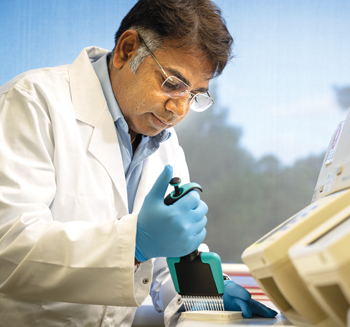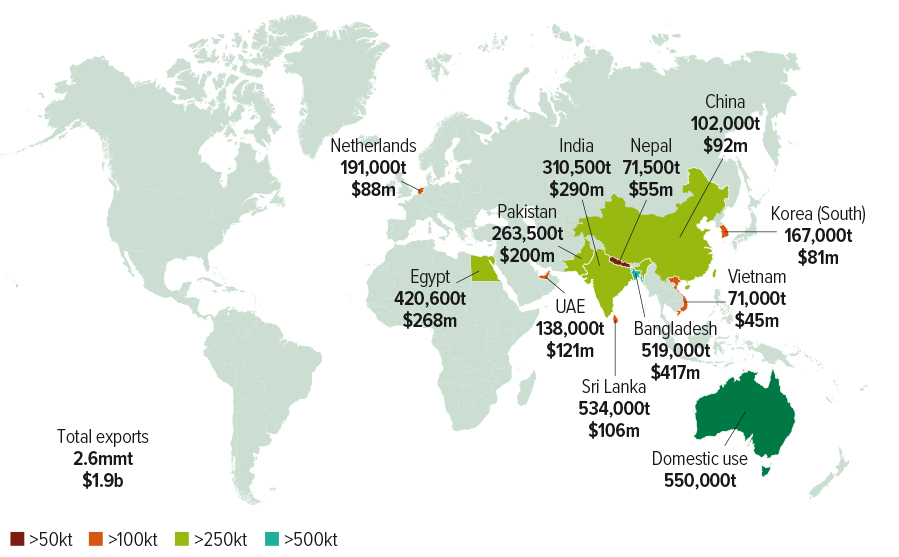Key points
- GRDC is investing $17.9 million in five new pulse pre-breeding projects targeting chickpeas, faba beans, lentils, lupins, mungbeans and field peas
- A significant focus is on expanding genetic diversity to enhance yield, disease resistance and environmental stress tolerance
- Researchers aim to increase annual yield gains in chickpeas, faba beans and lentils from 0.5 per cent to 1.5 per cent through genetic improvement
- Enhancing nitrogen fixation in six key pulses and improving heat tolerance in chickpeas will contribute to the development of more resilient and productive varieties
A targeted project on Botrytis grey mould in lentils and chickpeas will improve disease management, reducing crop loss risk for growers
The genetic diversity of chickpea, lentil, faba bean, lupin, mungbean and field pea varieties will be enhanced via five new projects. Across the next six years GRDC will invest more $17.9 million to ensure these crops are more robust, easier to grow and profitable.
Dr Camilla Hill, GRDC genetic technologies manager (pulses), is coordinating these investments.
Genetic gains for yield gains
Genetic gains for yield improvement in pulses have trailed behind other crops, something this new project, ‘Achieving improved genetic gain for yield in chickpea, faba bean, and lentil using genetic diversity’, aims to address.
Dr Hill says genetic gain has ranged from 0.5 to 1.25 per cent, averaging at about 0.5 per cent. The aim is to improve this to be on par with other crops such as wheat.
This project is a five-year investment to expand genetic diversity. It will also include ‘PulseBase’, an international genetic database for chickpeas, faba beans and lentils, comprising data from up to 300 lines for each crop. GRDC will invest $6.1 million in the $11.02-million project.
Led by Professor Rajeev Varshney from Murdoch University (MU), co-investors include the University of Queensland (UQ), Department of Energy, Environment and Climate Action (DEECA), New South Wales Department of Primary Industries and Regional Development (NSW DPIRD), University of Adelaide (UA), University of Sydney, and the International Centre for Agricultural Research in the Dry Areas (ICARDA).
 Professor Rajeev Varshney, director of the Centre for Crop and Food Innovation at Murdoch University, is leading a project to broaden the genetic diversity of pulse cultivars and drive yield gain. Photo: Evan Collis
Professor Rajeev Varshney, director of the Centre for Crop and Food Innovation at Murdoch University, is leading a project to broaden the genetic diversity of pulse cultivars and drive yield gain. Photo: Evan Collis
Professor Varshney says limited genetic diversity has hampered the ability of plant breeders to improve varieties. “We are partnering with ICARDA, a global research centre, to import new diverse germplasm for the three target crops,” Professor Varshney says.
“Once the data from the ICARDA germplasm has been analysed, we will develop DNA catalogues to share with leading Australian pulse breeding programs.”
Researchers will use genomic prediction, artificial intelligence and speed breeding to identify and stack novel and superior DNA variants for yield and yield-related traits.
“Ultimately, we want to develop high-yielding, climate-resilient chickpea, faba bean and lentil varieties that can deliver greater profitability to growers across Australia. With this investment, we can implement modern genomic approaches coupled with huge genetic diversity,” Professor Varshney says.
By incorporating genetic diversity from other landraces and employing advanced breeding techniques and AI, we believe we can achieve a 1.5 per cent increase in yield genetic gain, which would be unprecedented.
Enhancing nitrogen fixation
There is great potential to increase pulses’ nitrogen fixation via plant breeding and GRDC’s second major investment aims to do that.
The project, ‘Genetic initiative to transform symbiotic nitrogen fixation in Australian pulse crops’, focuses on chickpeas, lentils, field peas, faba beans, lupins and mungbeans.
Pulses fix nitrogen from both the atmosphere and the soil. However, there is great potential to increase nitrogen fixation in pulses by harnessing the natural variations of this ability that different lines or varieties have through breeding. This would leave more nitrogen in the soil for subsequent crops and reduce the use of synthetic nitrogen fertilisers and their loss to the environment.
This project will develop tools to measure nitrogen fixation, screen pulses for superior nitrogen ‘fixers’ and use AI-guided genomic selection to breed novel plant genotypes with enhanced nitrogen-fixing capabilities.
 Using genetic selection, Professor Michael Udvardi hopes to increase the nitrogen fixation and protein content of Australian pulses. Photo: University of Queensland
Using genetic selection, Professor Michael Udvardi hopes to increase the nitrogen fixation and protein content of Australian pulses. Photo: University of Queensland
GRDC will invest $5.9 million in the $14.7-million, five-year project.
Led by Professor Michael Udvardi at UQ, co-investors include La Trobe University, Australian National University, UA, MU, NSW DPIRD, CSIRO, Australian Grain Technologies, University of California Davis, and Queensland Department of Agriculture and Fisheries (QDAF).
Professor Udvardi says the long-term goal is to increase nitrogen fixation by at least 10 per cent. “We also aim to increase the total protein content of harvested seed, add to soil nitrogen for subsequent crops, and increase the profitability of our primary producers,” he says.
“What excites me about this project is that it brings together researchers working on the fundamental science of nitrogen fixation in legumes with plant breeders and agronomists working on applied aspects of pulse improvement to focus on improving nitrogen fixation in six of Australia’s pulses simultaneously.
“I expect that this collaborative and focused effort, using cutting-edge genomics, natural variation and predictive breeding, will lead to new and more effective ways to improve nitrogen fixation in our pulse species,” he says.
The nitrogen research is expected to use genetic information collated into PulseBase.
Rhizobia resources expanded
Since the 1950s, improved rhizobia strains – their introduction, characterisation, storage and identification – have been critical to the ongoing success of grain legumes and pastures.
A paramount and ongoing goal is to ensure that this continues, and that growers have timely access to the most effective and reliable inoculant strains each season. This is underpinned by the availability of well-characterised, authentic rhizobia strains. To that end, GRDC is investing in enhancing nitrogen fixation through improved rhizobia.
A recently completed six-year project at MU collated more than 11,000 rhizobia strains into the International Legume Inoculant Genebank at the university’s Legume Rhizobium Sciences Centre.
MU senior lecturer Dr Jason Terpolilli says this is the world’s largest and most diverse collection of rhizobia. He will lead a new GRDC-supported project to enhance the collection’s value.
GRDC will invest $2.15 million in the new $5.35-million project, with co-investment from MU and the Western Australian Department of Primary Industries and Regional Development.
“All of the pulses we grow in Australia are exotic, so the rhizobia they fix nitrogen with are not naturally present in Australian soils,” Dr Terpolilli says.
“The genebank is important to help us identify rhizobia that are optimally matched for different pulses and growing conditions across Australia. Getting the legume–rhizobia partnership right is critical to ensuring pulses fix the maximum amount of nitrogen.”
As part of the new four-year project, historic rhizobia strains in the collection will be genome sequenced, along with any new strains added, and public access to genebank data will be enhanced.
Dr Terpolilli says this data will be used to develop molecular techniques. Using different rhizobia to inoculate pulse crops, these techniques will quantify the success of nitrogen fixation. This will allow the more targeted use of inoculants to optimise nitrogen fixation.
The project will also develop new techniques to preserve rhizobia for future study and use.
Figure 2: Major markets for Australian pulses.

Source: AEGIC
Improving heat tolerance in chickpea
To make pulses – and chickpeas in particular – available to more growers, improving heat tolerance is critical. High temperatures during the reproductive phase pose a significant threat to yield and grain quality.
UQ’s Dr Millicent Smith says high temperature tolerance is complex. “But we are focused on understanding the trait combinations that confer an advantage,” Dr Smith says.
Dr Smith is leading the project, called ‘Fast tracking deployment of chickpea heat tolerance to develop chickpea varieties with improved high temperature tolerance’. This four-year, $8.6-million project includes $3.35 million from GRDC and co-investment from UQ, Flinders University, QDAF, NSW DPIRD, USYD, MU and Frontier Farming Systems (FFS).
Figure 1: Five-year average of Australian pulse production to 2022–23.

Source: ABARES/AEGIC
“The multidisciplinary team brings together experts in agronomy, plant breeding, crop physiology, crop modelling, genomics and genetics located across Australia,” Dr Smith says.
“We want to ensure that Australian growers maintain their competitive edge, which means new varieties with improved genetics to cope with heat stress are essential now and into the future.”
The project will test a set of international and Australian chickpea germplasm with genetic variability in both controlled environments and field experiments. The aim is to understand which traits and associated genomic regions are responsible for increasing high-temperature tolerance in the different varieties.
“The traits we are focused on are highly quantitative, so AI-guided breeding approaches help to rapidly stack desirable genetics into elite germplasm,” Dr Smith says. “And close partnership with industry means chickpea growers should reap rewards sooner.”
Improving heat tolerance is expected to help growers expand the sowing windows for chickpea in response to seasonal conditions, and to expand the regions where the crop can be grown.
UAV aid in Botrytis grey mould research
A new, targeted project will address Botrytis grey mould (BGM). Caused by Botrytis cinerea in chickpeas and both B. cinerea and B. fabae in lentils, BGM presents a significant biotic stress challenge.
While some Australian lentil varieties show moderate resistance, all chickpea varieties are susceptible. There is limited information on identifying and genetically characterising resistant germplasm in these crops.
‘Towards developing improved resistance to BGM in chickpea and lentil’ is a GRDC-supported project led by Associate Professor Lars Kamphuis at Curtin University, with co-investment from DEECA, the International Crops Research Institute for the Semi-Arid Tropics, and ICARDA. GRDC is investing $1 million in the $1.85-million, three-year project.
Glasshouse and field trials will explore how the infection progresses and its impact on plants. The team will optimise phenotyping assays for breeding programs and conduct field trials for chickpeas and lentils.
Dr Hill says the project will use unmanned aerial vehicles (UAVs) to capture images for large-scale phenotyping. “This will help see whether this technology can determine the level of BGM infection and the severity of the damage,” Dr Hill says.
“We need robust phenotypic data, complemented by genetic insights, to deepen our understanding of this disease’s genetics and support breeders in developing superior varieties.”
The insights from UAV field phenotyping could benefit other pulse crops too. Optimised phenotyping methods like this could help identify resistant germplasm for chickpea and lentil breeders.
These five projects are part of GRDC’s broader investment in pulse research aimed at de-risking pulse production for growers.
“There’s a very strong capacity-building element to these projects, supporting established researchers and PhD students, which will continue to benefit future research,” Dr Hill says.
“By enhancing genetic diversity, nitrogen fixation, disease resistance and heat tolerance, these projects aim to boost productivity, sustainability and profitability for Australian growers, ensuring a robust and resilient pulse industry for the future.”

























































